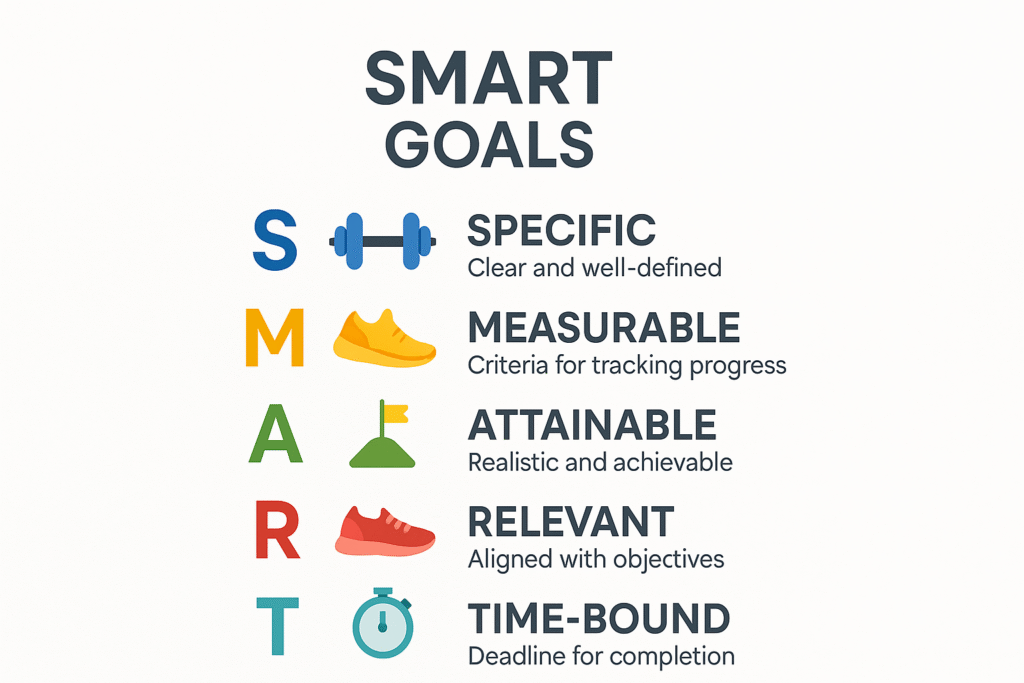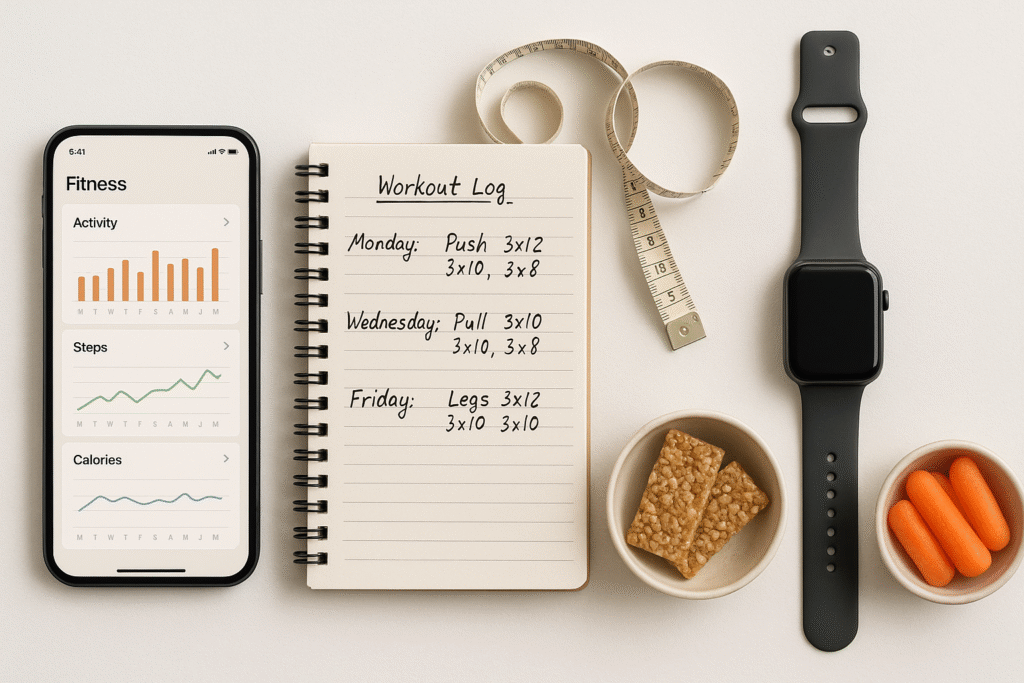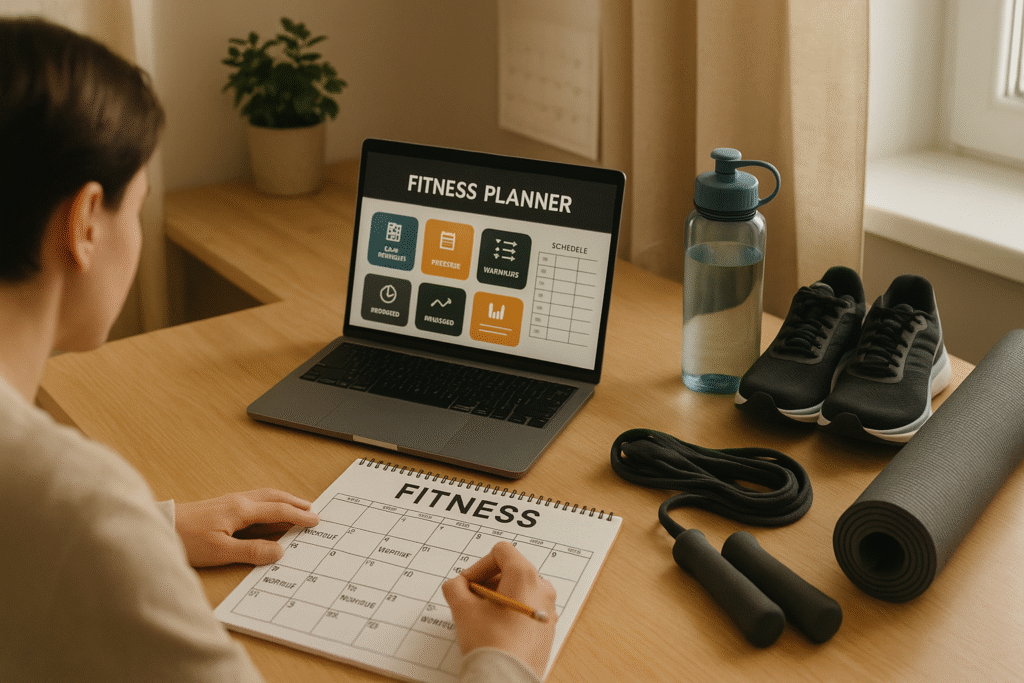Setting fitness goals is easy—sticking to them is the real challenge. If you’ve ever started a workout routine with enthusiasm only to abandon it weeks later, you’re not alone. The difference between those who achieve lasting fitness success and those who struggle lies in how they set their goals. Enter SMART fitness goals: a proven framework that transforms vague intentions into actionable, achievable plans.
What Are SMART Fitness Goals?

SMART fitness goals represent a systematic approach to goal setting that originated in business management but has proven incredibly effective for health and fitness applications. This framework replaces wishful thinking with strategic planning, giving you a clear roadmap to success.
The SMART acronym stands for:
- Specific: Clear and well-defined objectives
- Measurable: Quantifiable progress indicators
- Attainable: Realistic and achievable targets
- Relevant: Meaningful to your personal situation
- Time-bound: Set within a specific timeframe
Unlike vague resolutions like “get healthier” or “exercise more,” SMART goals provide structure and accountability. Research in behavioral psychology shows that people who set specific, challenging goals perform significantly better than those with vague or easy goals.
Breaking Down the SMART Framework for Fitness
Specific: Define Your Exact Objective
Specificity eliminates ambiguity and creates focus. Instead of saying “I want to lose weight,” a specific goal would be “I want to lose 15 pounds of body fat while maintaining muscle mass.”
Examples of specific fitness goals:
- Run a 5K race without stopping
- Perform 20 consecutive push-ups
- Attend yoga classes twice per week
- Reduce body fat percentage from 25% to 20%
- Increase daily step count to 10,000 steps
The key is answering the “what, why, and how” of your fitness objective. What exactly do you want to achieve? Why is this important to you? How will you accomplish it?
Measurable: Track Your Progress
Measurable goals allow you to monitor progress and stay motivated. They provide concrete evidence of improvement and help you adjust your approach when needed.
Measurable fitness metrics include:
- Weight, body fat percentage, or muscle mass
- Distance, speed, or duration for cardio activities
- Repetitions, sets, or weight lifted for strength training
- Frequency of workouts per week
- Heart rate zones during exercise
- Flexibility measurements or range of motion
For example, instead of “improve cardiovascular fitness,” try “increase my 5K running time from 35 minutes to 28 minutes.” This gives you a clear benchmark and allows you to track weekly improvements.
Attainable: Set Realistic Expectations
Attainable goals challenge you without setting you up for failure. They should stretch your capabilities while remaining within the realm of possibility given your current fitness level, schedule, and resources.
Factors to consider for attainability:
- Your current fitness level and experience
- Available time for exercise
- Access to equipment or facilities
- Physical limitations or health conditions
- Other life commitments and responsibilities
A sedentary person shouldn’t aim to run a marathon in two months, but training for a 5K in 8-12 weeks is perfectly attainable. The goal is to create positive momentum through achievable wins.
Relevant: Align with Your Values and Lifestyle
Relevant goals connect to your personal values, lifestyle, and long-term health objectives. They should matter to you personally, not just sound impressive to others.
Questions to ensure relevance:
- Does this goal align with my overall health priorities?
- Will achieving this improve my quality of life?
- Is this goal compatible with my current life situation?
- Does this support my long-term wellness vision?
For instance, if you’re a busy parent, a relevant goal might focus on home workouts or family-friendly activities rather than gym-based routines that require significant time away from home.
Time-bound: Create Urgency and Structure
Time-bound goals create urgency and prevent procrastination. They provide a clear deadline that helps you plan your approach and maintain momentum.
Effective timeframes for fitness goals:
- Short-term goals: 4-12 weeks
- Medium-term goals: 3-6 months
- Long-term goals: 6-12 months
For example: “Complete a beginner’s strength training program, working out 3 times per week for 8 weeks, and increase my bench press from 95 pounds to 115 pounds.”
Diverse SMART Fitness Goal Examples for Every Level
Beginner Goals
- Cardio: “Walk for 30 minutes, 5 days per week for the next 6 weeks to improve my cardiovascular endurance”
- Strength: “Complete 2 full-body strength training sessions per week for 8 weeks, progressing from bodyweight exercises to light weights”
- Flexibility: “Attend one yoga class per week for 3 months to improve my flexibility and reduce lower back pain”
Intermediate Goals
- Endurance: “Train for and complete a 10K race in under 55 minutes within 4 months”
- Strength: “Increase my deadlift from 135 pounds to 185 pounds over 12 weeks with proper form”
- Body Composition: “Reduce body fat percentage from 22% to 18% in 16 weeks through consistent exercise and nutrition tracking”
Advanced Goals
- Performance: “Complete an Olympic-distance triathlon in under 3 hours within 6 months”
- Strength: “Achieve a bodyweight pull-up (currently unable) within 3 months through progressive training”
- Skill-based: “Master advanced yoga poses including crow pose and headstand within 4 months of consistent practice”
Adapting SMART Goals for Different Fitness Levels and Limitations
For Beginners
Start with habit formation rather than performance metrics. Focus on consistency over intensity. A goal like “Exercise for 20 minutes, 3 times per week for 4 weeks” builds the foundation for more ambitious objectives later.
For Those with Physical Limitations
Adapt goals to work within your constraints while still challenging yourself. Someone with knee issues might set a goal like “Complete 30 minutes of low-impact cardio (swimming or cycling) 4 times per week for 8 weeks to improve cardiovascular health.”
For Busy Professionals
Focus on efficiency and integration with daily routines. Examples include “Complete three 20-minute high-intensity interval training sessions per week during lunch breaks for 6 weeks” or “Take the stairs instead of elevators for all buildings under 5 floors for 30 days.”
Advanced Progress Tracking Methods

Digital Tracking Tools
- Fitness apps: MyFitnessPal, Strava, or Fitbit for comprehensive tracking
- Wearable devices: Heart rate monitors, fitness trackers, and smartwatches
- Specialized apps: Couch to 5K for running, StrongLifts for weightlifting
Traditional Tracking Methods
- Workout journals: Record exercises, sets, reps, and how you felt
- Progress photos: Visual documentation of body composition changes
- Measurement logs: Track weight, body measurements, and performance metrics
Advanced Metrics
- Heart rate variability: Indicates recovery and training readiness
- Sleep quality: Crucial for recovery and performance
- Subjective wellness scores: Rate energy, mood, and motivation daily
Comprehensive Accountability Strategies
Personal Accountability
- Daily check-ins: Review your goals and progress each morning
- Weekly assessments: Evaluate what worked and what needs adjustment
- Reward systems: Celebrate milestones with non-food rewards
- Visual reminders: Post goals where you’ll see them daily
Social Accountability
- Workout partners: Find someone with similar goals and schedules
- Online communities: Join fitness groups on social media or apps
- Professional support: Work with personal trainers or fitness coaches
- Family involvement: Share your goals with supportive family members
Environmental Accountability
- Scheduled workouts: Treat exercise appointments as non-negotiable
- Prepared environment: Lay out workout clothes the night before
- Remove barriers: Eliminate excuses by preparing in advance
- Create consequences: Donate to charity if you miss workouts
Overcoming Common Obstacles and Setbacks
Plateau Periods
When progress stalls, reassess your approach. Your body adapts to routines, so introduce new challenges:
- Increase intensity or duration
- Try different exercise modalities
- Adjust your nutrition approach
- Ensure adequate recovery time
Motivation Dips
Motivation naturally fluctuates. Build systems that work even when motivation is low:
- Focus on minimum effective dose (what’s the least you can do?)
- Have backup plans for busy days
- Remember your “why” – the deeper reason behind your goals
- Celebrate small wins to maintain momentum
Life Disruptions
Unexpected events will challenge your routine. Build flexibility into your goals:
- Create “if-then” scenarios for common disruptions
- Have home workout alternatives
- Adjust timelines when necessary without abandoning goals
- Focus on maintaining habits rather than perfect execution
Integrating Nutrition and Lifestyle Factors
Nutrition Alignment
Your fitness goals should complement your nutritional approach:
- For muscle building: Ensure adequate protein intake (0.8-1g per pound of body weight)
- For fat loss: Create a moderate caloric deficit while maintaining nutrient density
- For endurance: Focus on carbohydrate timing around workouts
- For recovery: Prioritize post-workout nutrition within 30-60 minutes
Sleep and Recovery
Quality sleep is crucial for achieving fitness goals:
- Aim for 7-9 hours of quality sleep nightly
- Maintain consistent sleep and wake times
- Create a sleep-conducive environment
- Limit screen time before bed
Stress Management
Chronic stress can sabotage fitness progress:
- Incorporate stress-reduction techniques like meditation or deep breathing
- Balance high-intensity workouts with recovery activities
- Address work-life balance issues that create chronic stress
- Consider yoga or tai chi for combined fitness and stress relief
Long-term Maintenance Strategies

Goal Evolution
As you achieve your initial SMART goals, evolve them to maintain progress:
- Set new challenges that build on previous successes
- Explore different aspects of fitness (strength, endurance, flexibility, balance)
- Consider sport-specific or skill-based goals
- Focus on maintenance phases between growth periods
Habit Integration
Transform temporary goals into permanent lifestyle changes:
- Identify which habits serve you long-term
- Create systems that make healthy choices automatic
- Build flexibility into your routine for sustainability
- Focus on identity change (“I am someone who exercises regularly”)
Continuous Learning
Stay engaged by expanding your fitness knowledge:
- Learn new exercise techniques or sports
- Understand the science behind your training
- Experiment with different approaches
- Share your knowledge with others
Frequently Asked Questions
How long should I stick with one SMART goal before setting a new one?
Most fitness goals should have timeframes of 4-12 weeks. This allows enough time to see meaningful progress while maintaining motivation. After achieving a goal, take time to assess and set your next objective.
What if I don’t achieve my SMART goal within the set timeframe?
First, celebrate the progress you did make. Then analyze what factors contributed to falling short. Was the goal too ambitious? Did life circumstances change? Use this information to set a more appropriate goal moving forward.
Can I have multiple SMART fitness goals at once?
Yes, but be strategic. Limit yourself to 2-3 goals maximum to avoid spreading your focus too thin. Ensure they complement rather than compete with each other. For example, a strength goal and a flexibility goal can work well together.
How do I know if my goal is truly attainable?
Research what others with similar starting points have achieved in comparable timeframes. Consult with fitness professionals if you’re unsure. It’s better to achieve a slightly easier goal and build confidence than to fail at an overly ambitious one.
Should I adjust my goals if I’m progressing faster than expected?
Absolutely! If you’re ahead of schedule, you can either accelerate your timeline or make your goal more challenging. This keeps you engaged and maximizes your progress potential.
Your Next Steps to SMART Fitness Success
SMART fitness goals aren’t just about achieving specific outcomes—they’re about developing a systematic approach to health and wellness that serves you for life. By implementing this framework, you’re not just setting yourself up for short-term success; you’re building the skills and mindset necessary for lifelong fitness.
Start today by choosing one area of your fitness you’d like to improve. Apply the SMART criteria to create a specific, measurable, attainable, relevant, and time-bound goal. Write it down, share it with someone who will support your journey, and take the first action step immediately.
Remember, the goal isn’t perfection—it’s progress. Every step forward, no matter how small, brings you closer to the healthier, stronger version of yourself you’re working to become. Your future self will thank you for the commitment you make today.
Ready to transform your fitness journey? Set your first SMART goal now and take the first step toward lasting health and wellness success.



